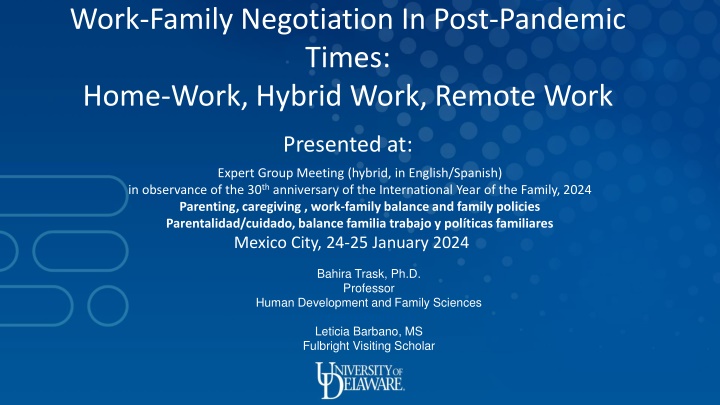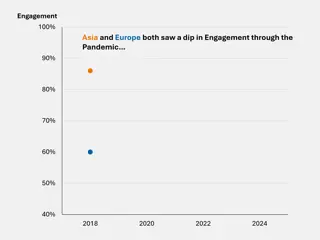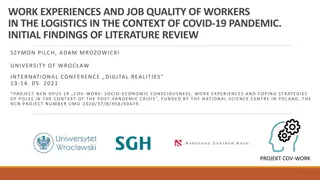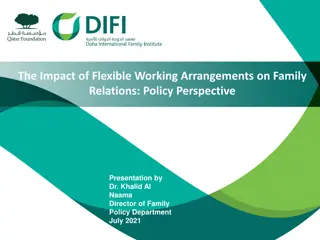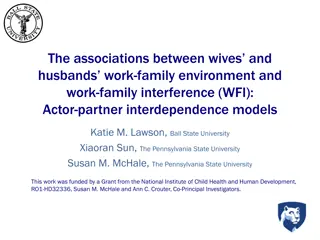Global Work-Family Dynamics: Post-Pandemic Challenges
The presentation discusses the evolving landscape of work-family negotiations in a post-pandemic world, addressing issues such as gender inequality, demographic shifts, and societal transformations. It emphasizes the impact of COVID-19 on work dynamics and family structures, highlighting the need for businesses to adapt to changing norms and values in the workplace. The session explores the intersection of work and family life, calling for a reevaluation of traditional roles and policies to achieve a better work-family balance.
Download Presentation

Please find below an Image/Link to download the presentation.
The content on the website is provided AS IS for your information and personal use only. It may not be sold, licensed, or shared on other websites without obtaining consent from the author.If you encounter any issues during the download, it is possible that the publisher has removed the file from their server.
You are allowed to download the files provided on this website for personal or commercial use, subject to the condition that they are used lawfully. All files are the property of their respective owners.
The content on the website is provided AS IS for your information and personal use only. It may not be sold, licensed, or shared on other websites without obtaining consent from the author.
E N D
Presentation Transcript
Work-Family Negotiation In Post-Pandemic Times: Home-Work, Hybrid Work, Remote Work Presented at: Expert Group Meeting (hybrid, in English/Spanish) in observance of the 30thanniversary of the International Year of the Family, 2024 Parenting, caregiving , work-family balance and family policies Parentalidad/cuidado, balance familia trabajo y pol ticas familiares Mexico City, 24-25 January 2024 Bahira Trask, Ph.D. Professor Human Development and Family Sciences bstrask@udel.edu Leticia Barbano, MS Fulbright Visiting Scholar
Work-Family Issues Are Global, Complex & Interrelated COVID-19 has highlighted the work-family intersection: Often seen as private but now it is public Outdated presumption about structure of families: men as the economic providers / women as homemakers Ideological shifts Feminism; roles of men and women; role of work among different generations Businesses have to respond in light of these changes; also an increase in automation, outsourcing, market forces & pressure for profits now also the pandemic and AI
Global Societal Transformations Changing demographics / structures of families Increase in single parenting through divorce, separation and cohabitation childbearing Growth of the elderly population Rise of women in the global labor force Has exacerbated care across spectrum growing problem in high and low-income countries Globalization Families abilities to control their economic and social well-being has decreased Family arena remains primary site for these negotiations Complex intersection of role of states and business in family life
Gender Issues Persist in the Workplace Report by OECD (2011) indicated that a majority of employers expect women to drop out of the paid labor force once they have children regardless of their level of education Less invested in training women Women considered less committed Reduces incentives for women to pursue advances vicious circle Men reluctant to use family-focused policies (such as paid leave unless it is mandatory)
Drop out Rates of Women During Covid-19 Women dropped out of the workforce at much higher rates (OECD, 2021) OECD analysis: women with children under 12 were most likely to leave the labor force In US by 2022, men had regained all their jobs vs 1.8 million jobs lost by women Highlighted gendered nature of care 61% women said they took on care work vs. 22.4% men (OECD, 2021) Germany women (mothers) who were working from home became completely responsible for care work; Perceived differently by women and men 4
Gender Still Matters at Home Despite higher labor force participation rates: Women continue to bear most of home responsibilities Caring for children / elderly / disabled/ ill Domestic work In all areas of the world, women spend AT LEAST twice as much time as men on unpaid, domestic work OECD countries (2021): women spend 2 hours more on unpaid domestic work; Women in precarious jobs spend more time on unpaid care than women in stable employment (OECD 2021) Women provide physical personal childcare and housework Men provide educational / recreational children s activities
SDGs and Agenda 2030: Goal 5 - Achieve gender equality and empower all women and girls Provide women and girls with equal access to education, health care, decent work, and representation in political and economic decision-making processes will fuel sustainable economies and benefit societies and humanity at large.
Contemporary Situation: Gender & Families The UN SDG s and the UN Conferences have been responsible in large part for turning the attention of governments to issues related to social (instead of just economic) developments Benefits: Rights of women on the increase Negative: Role of families increasingly obscured /ignored Through globalization, work-family negotiation world-wide issue
What Have We Achieved With Respect To This Target? Largest body of research: United States Western Countries, especially the Nordic countries Focus on families with young children: Ignores other caretaking responsibilities Not just a women s issue 8
Regional Differences East Asian, Nordic, southern European countries. U.S.: Women and men work mostly full time Australia, Germany, UK, Middle East / North Africa; Increase in female employment is primarily in part-time work OECD countries: 21.7% women work part time vs. 4.4% men Sub-Saharan Africa / South Asia Women more than men in vulnerable employment family workers; self- employed Latin America; Caribbean Three- quarter of employment of women in service sector 9
Occupations & Gender Relative to overall share of total employment: Women underrepresented in top positions; trades; managers; 7 of 150 elected Heads of State in the world are women, and only 11 of 192 Heads of Government. Of the 500 largest corporations in the world, only 13 have female CEOs Women overrepresented as clerks, professionals, service, sales workers Gender pay gap 16 % in OECD countries Closing in some Western countries; Unchanged in others (UN Report on Women, 2019) 10
Work-Family Conflict in the United States Families and Work Institute: 1/3 of U.S. employees have to choose between advancing in their jobs and attending to their family needs OECD U.S. in bottom third of 34 countries with respect to work-life balance U.S. only high-income country that does NOT provide federal paid leave for birth of a child Highest number of hours worked outside of the home 11
Employment, Family Formation & Stability Gender, employment and wage gaps are also related to family formation Increasingly employment rates similar for men and women in their 20 s Issue of steady employment vs vulnerable employment Patterns diverge with the birth of children Men work the same hours OR more (Australia, UK) Women s employment participation drops when young children are in the household (OECD, 2021)
Unpaid Work & Gender Burden of unpaid work contributes to gender inequality Families with and without children, women spend a substantial amount of time on care work (OECD, 2021) Mexico (no children): women 25- 44: 8% of their time vs. men at 3% Mexico: 43% employment rate of women; they spend more than 6 hours a day on unpaid work Finland (2 children): women 25 44: 20% of their time vs. men at 10% 13
Unpaid Labor Remains Invisible On public level: Women s unpaid care contributions not accounted for in governmental and transnational analyses of labor markets and employment situations In private realm of the family: Men s financial contributions linked to greater power around decision- making Women s unpaid labor and care is produced for use and NOT for exchange 14
UN Agenda 2030 Target 5.4 states: One important goal of the new directives is the recognition and value [of] unpaid care and domestic work through the provision of public services, infrastructure and social protection policies and the promotion of shared responsibility within the household and the family as nationally appropriate. 15
The Fundamental Problem with Implementation: Issues Vary Across the World West research / policies: Dual-earner couples Work family spillover / stress Work division of labor at home Gender Roles Business: Family-Friendly (caretaking of young & elderly) Focus on middle-class Workplace flexibility Quality childcare Maternity and family leave Significant differences in experiences based on social class and education often ignored 16
Issues Vary Across the World and Within Societies Non-Western countries Significant differences in experiences based on social class and education Some countries governments have relaxed laws with respect to employment practices Low wages Safety and environmental concerns Outsourcing / home-based work Cultural issues around gender roles often more rigid than in the West Variation across social class / region 17
What Can Be Done? More studies and research to address local needs Connect researchers with government and NGOs to achieve solutions for local people Use examples and case studies from other countries and regions as inspiration Laws to guarantee access to paid (formal) employment with good working conditions, especially for women Work toward the same duration of paid maternity and paternity leave Access to high-quality and public childcare services Reduce the full-time working week to less than the common standard of 40 hours 18
Flexibility Leads To A Better Bottom Line For Businesses Researchers at the U.S. based Work Institute found work/life balance issues such as child-care problems and rigid working hours to be important reasons for job resignation The American Society for Healthcare Human Resources found that companies with the best retention records offered flexible scheduling, hybrid work and more vacation time Having control over when and were to work allows workers to juggle In the U.S.: translates into a savings of up to $300 billion per year, or between $496 and $1,984 per employee per year 19
Sweden As The Case Example Swedish government promoting gender- equal roles through work-life balance legislation and encouraging men s involvement in caregiving Swedish women: highest rate of female employment 90 percent of working mothers report no role conflict Lowest level of single mothers in poverty (family friendly programs and social transfer programs) 20
Evidence Based Policies: Scandinavian Countries Regular cross-training and job rotation Giving worker teams more autonomy and responsibility for their own work Measuring productivity by performance rather than by work hours Regularly phasing in new people into long-term projects Developing alternative career paths for specialists and managers Allowing careerists with small children to take responsibility Allowing more flexibility in terms of where work is performed (home, for example) Facilitating part-time work and job sharing, including management positions 21
Successful Policies From Some US Companies Compressed workweeks On-site childcare Breastfeeding rooms and paid breastfeeding breaks Company supported child-care backup After-school and summer programs for children Phase-back work after maternity leave On-site wellness programs Job-share opportunities 22
Remote Work: Two Sides of the Same Coin Remote work can reduce work-family conflict and increase job performance, especially for mothers (Sherman, 2019) Remote work and flexible jobs can lead to overwork (de Laat, 2023; Kelly, Moen, 2020) Problem: women tend to assume more domestic and caregiving tasks than men when she has (or both have) remote jobs (Dunatchik et al., 2021) Solution: cultural change regarding gender roles 23
Workplace Policies Affect Productivity Jobs defined based on goals instead of hours and location of work COVID has encouraged this approach Google: increased worker productivity, decreased turnover, less absenteeism Businesses that focus on this have a COMPETITIVE advantage: Larger talent pool for selection 24
Negotiating Family & Work Need to change the fundamental assumption that employee and employer interests are mutually exclusive, and in opposition to one another Need to focus on employees who are less educated and / or work in lower- income jobs Least likely to access family friendly policies Cultural and regional differences also matter Need to work with other systems in society (schools, health care providers, elder care programs) to re-design services for families this also benefits businesses
Family-friendly initiatives do not just support individuals and businesses: they also lead to ultimately making nations globally competitive 26
Recommendations Critical to embed a gender-sensitive approach to all work-life programs and policies (OECD, 2021) Gender lens needs to be part of implementation in order to ensure that gender stereotypes are not reinforced Access to formal care programs critical especially for low-income and rural workers Governments should aim to build policy that alleviates structural gender inequalities and to build gender-inclusive frameworks and plans taking into consideration inequalities at home, in the economy, and in society at large (OECD, 2021) 27
Concluding Thoughts People need to know that they can take time off from their jobs to perform their family duties without being penalized in the workplace This requires a cultural re-conceptualization about the role of work in people s lives and how productivity is defined. It also requires the recognition and support of the family unit as that which is still a central if not the central feature of most people s lives both in the West and in other parts of the world
Selected References de Laat, K. (2023). Living to work (from home): Overwork, remote work, and gendered dual devotion to work and family. Work and Occupations, 07308884231207772. Dunatchik, A., Gerson, K., Glass, J., Jacobs, J. A., & Stritzel, H. (2021). Gender, parenting, and the rise of remote work during the pandemic: Implications for domestic inequality in the United States. Gender & Society, 35(2), 194-205. Kelly E. L., Moen P. (2020). Overload: How good jobs went bad and what we can do about it (1st ed.). Princeton University Press Sherman, Eliot L. (2019). Discretionary Remote Working Helps Mothers Without Harming Non-mothers: Evidence from a Field Experiment. Management Science, (), mnsc.2018.3237 . doi:10.1287/mnsc.2018.3237 OECD. (2021). Caregiving in crisis. Gender inequality in paid and unpaid work during COVID-19. . 30
